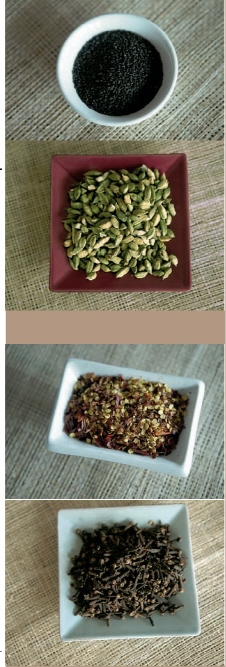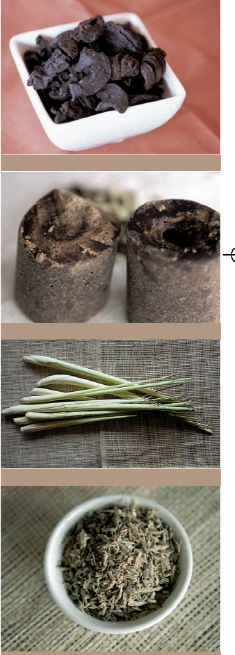
banana chillies – malu miris
Larger than a green chilli but smaller than a capsicum, banana chillies (Hungarian wax chillies) are a milder, sweeter version of the green chilli. Sri Lankans use them in curries or stuff them as a savoury snack.
basil seeds – khasa khasa
Basil seeds are used in desserts and drinks such as faluda. When soaked in water these little black seeds with their lemon basil scent develop a gelatinous coating but maintain a crunchy interior, similar to passionfruit seeds.
cardamom – enasa
Cardamom has a pungent flavour and is used in curry powders and desserts as well as in tea. The cardamom pod contains tiny black seeds, which can be extracted from the pod, but in many recipes the entire pod is used and discarded before serving, as a bay leaf would be. The spice is native to India.
chickpea flour
Also known as besan flour, chickpea flour is made from a smaller variety of chickpea and is used in batters for deep frying.
chilli – miris
You don’t get far in Sri Lankan cuisine without using chilli. Fresh green and red chillies are used in curries, along with dried red chilli flakes, ground chilli or chilli powder. Most Sri Lankan kitchens have a jar of salted chillies on hand for adding extra flavour to curries. These can also be deep-fried and served on the side of a main meal as a condiment.
cloves – karabu nati
Cloves are dried, unopened flower buds, which add a spicy flavour to curry powders. They need to be used sparingly as they are strong.

coconut milk – pol kiri
When buying canned coconut milk, always choose the unsweetened variety, as opposed to standard coconut milk, which is sweetened for use in desserts. Using coconut milk powder allows you to control the thickness of the milk, by adding more or less water depending on the recipe. Coconut milk powder is always unsweetened. You can make your own coconut milk by grating coconut flesh, mixing it with water in a food processor or blender and passing through a sieve to extract the milk. The flesh of 1 coconut takes about 3 cups of water to produce a thick milk. When you choose a coconut to buy, make sure you shake it to listen for the water inside. This indicates the flesh will be fresh.
coriander – kothamalli
Fresh coriander leaves have a strong lemon peel and sage flavour and are chopped and sprinkled over curry dishes. Coriander seeds also have a lemon flavour, and are roasted and ground to form a key component of curry powders. They are best used freshly ground for maximum flavour.
cumin – suduru
Pale brown cumin seeds have a strong, earthy flavour with a dried peppermint tinge and are essential to Sri Lankan curry powders. They are similar to fennel seeds but smaller.
curry leaves – karapincha
Curry leaves don’t taste like curry at all; their name comes from their essential role in curry dishes. The leaves are from the native Sri Lankan curry tree (Murraya koenigii) and have a citrus aroma – the tree belongs to the same family as oranges and lemons. The leaves can be used fresh or dried and are added to the pan with oil when you begin to make a curry. If you can’t find curry leaves, use one or two bay leaves instead – it’s not an ideal substitute as bay leaves don’t give the same flavour, but they will do the job.
curry powders, roasted and unroasted
Unroasted curry powder – or simply, curry powder – is mainly used in vegetarian curries while roasted curry powder has a darker colour and stronger flavour and is frequently used in meat curries. Unroasted curry powder is the standard powder you buy in supermarkets while roasted curry powder is a bit more of a specialty and is found in Asian or Indian supermarkets. You can make your own mix following recipes.
dhal
Dhal is the collective name for a wide variety of pulses (dried beans and peas) that are eaten daily in Sri Lankan homes in some form or other and that provide a valuable source of protein. Dhal is also the name for the dish itself, which is a thickish purée eaten with rice or bread. It is a popular breakfast dish and an essential component of every meal. See also urad dhal.
dried shrimp – kunisso
These tiny dried shrimp have a strong flavour and are used mainly in sambols and mallums. They can be bought from Asian groceries and good supermarkets.
fennel seeds – maduru
Fennel seeds are similar in appearance to cumin seeds but have a sweet aniseed flavour. They are used in curry powders.
fenugreek – uluhaal
A member of the pea family, fenugreek’s flat brown seeds are used dried in curry dishes, particularly vegetable and seafood dishes. Sometimes fennel seeds are soaked in water overnight, when they develop a gelatinous coating which is used as a thickening agent for curries.

ghee – elengethel
Ghee, or clarified butter, is popular in Indian and Sri Lankan cooking and can be heated to a higher temperature than butter. It is bought in cans at supermarkets.
gambodge – goraka
Gambodge (also known as kokam in many Western cultures) is a fruit similar to an orange and is used as a souring agent, in a similar fashion to tamarind. The fruit is bright orange when ripe, but is used dried in cooking, when the fruit segments have shrivelled to small black leathery pieces. Gambodge is used in fish and pork curries, mostly in pieces so it can be removed before eating.
jaggery – hakuru or jaggery
Also known as gulab melaka, jaggery is unrefined sugar from a palm tree or sugar cane and is commonly used in desserts.
lemongrass – sera
Lemongrass is another integral part of the curry flavour. Use the white section of the stalk only and bruise it with a mortar and pestle or the side of a knife to release the flavour. Lemongrass is often left whole in the dish and discarded before serving, or served but not eaten.
Maldive fish – umbalakade
Maldive fish, also known as dried tuna, is actually dried bonito fish, caught in the South China Sea and processed on the Maldive Islands which neighbour Sri Lanka. Few Sri Lankan dishes are served without Maldive fish flakes – some dishes are enhanced with a mere sprinkling of the dried fish while others, such as sambols, are carried by the flavour.

mustard seeds – aba
Brown mustard seeds can be bought in supermarkets and are used whole or ground in curries. If used whole, sauté in oil with curry leaves and onion until they ‘pop’ and release their flavours – about 30 seconds.
okra – bandakka
Okra are also known as lady’s fingers or gumbo. These green ribbed seed pods offer a good supply of vitamins A and C, as well as fibre, calcium and iron and are often used in Sri Lankan vegetable curries and dry stir-fries with Maldive fish.
pandanus – rampe
The stiff, bright green pandan leaf is used for its colour and flavour in curries and rice dishes. There is no substitute for the unusual nutty, grassy flavour of the leaf, which is cut into pieces and added to a dish, but removed prior to eating, or served as a garnish but not eaten.
red rice
Unpolished or unrefined rice, which contains more fibre than polished rice. Like brown rice, it takes longer to cook than white rice and can be bought from organic shops, Asian groceries and good supermarkets.
rose syrup
A sweet rose syrup that can be bought from Asian grocery stores or made from equal quantities of fragrant rose petals, sugar and water, boiled for 10–15 minutes or until the mixture forms a thick syrup.

snake beans – ma-karal
Snake beans are also known as asparagus bean, yard-long bean and Chinese long bean. The long, dark green beans are popular in Sri Lanka as a curry dish.
sweet paprika
This bright red powdered spice is used for colour as an alternative to chilli powder – perfect for those who prefer a milder dish without losing any of the spicy look.
tamarind – siyambala
The pulp of tamarind pods adds a sour flavour to dishes, usually fish and meat curries. You can buy tamarind as a pod, dried in a block, or as a concentrate in jars from Asian grocery stores.
turmeric powder – kaha
This bright orange rhizome, which looks like a small version of ginger, is used in Sri Lankan cuisine for its vibrant yellow colour. Water coloured with turmeric is sprinkled in Sri Lankan houses for good luck. It is a good substitute for the more expensive spice saffron.
urad dhal
This comes in two forms. It is white in colour when hulled and split, or black when the grains are unhulled and whole. Urad dhal is also known as black gram. Use green or yellow split peas as an alternative.
water spinach – kangkung
Water spinach leaves are long, pointed dark green leaves which, like spinach, require very little cooking. They are ideal for stir-fries and are a common green vegetable in Sri Lankan cuisine.
